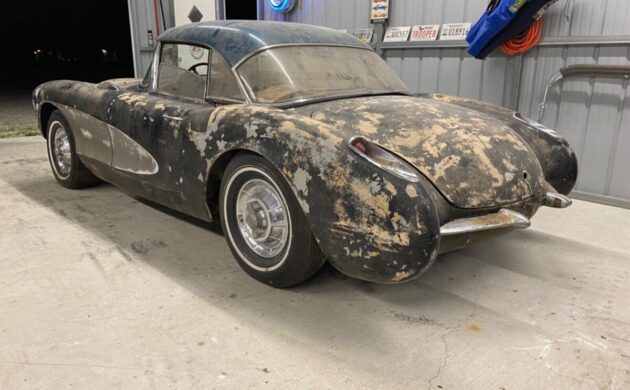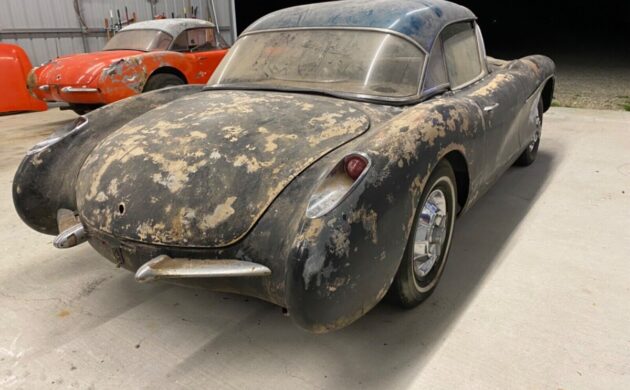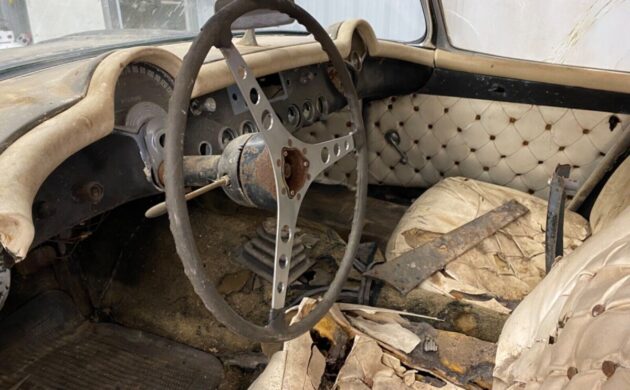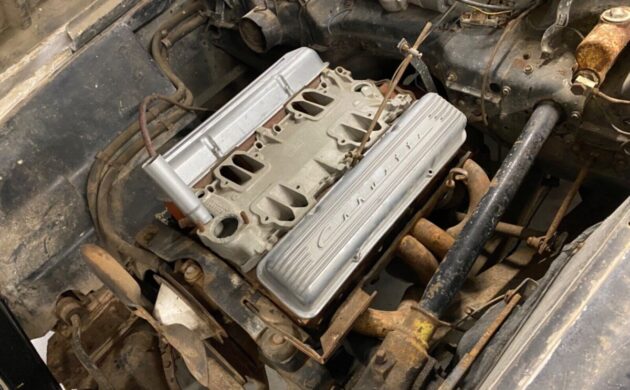1957 was a significant year for the Chevrolet Corvette. After the debut of this show car gone mainstream, Corvette sales floundered to the point that cancellation made sense. However, the installation of a V-8 in 1955, a handsome restyle in 1956, and the introduction of fuel injection in 1957 were three of the forces that built respect for the car and secured its future. This 1957 Corvette project car for sale on eBay in Walker, Louisiana could be your opportunity to purchase one at a sensible price. With bidding at $25,400 and a Buy It Now price of $35,000, is this rough but ready ’57 with a fuelie manifold the real deal or a clone in the making?
The Corvette has been looked down upon by a segment of sports car purists from day one. With the 1953-1955 cars, they had some validity to their arguments. The heavy inline six-cylinder engine and the Powerglide two-speed automatic transmission weren’t exactly the ingredients required for glory at LeMans. As time went on, the car attracted people at General Motors that championed the car. Their efforts lead to incremental improvements that moved it closer to the goal of being a true sports car.
A whole in the purist’s flawed argument is the complaint that the Corvette used production car components. If that standard was applied to every acknowledged sports car in production at the time, only the most exotic would qualify. Every sports car manufacturer from Austin-Healey to Porsche used a certain percentage of off-the-shelf components to produce their cars. Most of these were parts sourced from economy cars.
Yet, if you are going to brand the Corvette as somehow inferior for having rather pedestrian components, there is one regular production that Chevrolet had that few could match: the small block Chevrolet V-8. This engine powered millions of sedans in the fifties. It also powered a lot of race cars that snatched checkered flags from competitors of every make. In fuel-injected form, this engine was a beast on the street and at the drag strip. In sports car racing, the new invention would take a while to perfect. Yet, the potential was there in bulk. Many people look to 1957 as the real start to the Corvette being a true sports car, and the introduction of fuel injection was just one deciding factor.
If you want one for your garage, then this may be your lucky day. The Corvette you see here is a 1957 model that is advertised as a project car. There is little in the way of detailed description in the ad. The seller describes the car by basically saying what you see in the pictures is what you get. It neither runs nor drives is clearly stated and is obvious from the pictures. Those pictures also paint the all-to-familiar picture of this car having a rough life of successive owners who added their creative touches to the car. Take for example the photo above displaying the upholstery handiwork of an obvious Liberace School of Auto Upholstering graduate. At least we know that the car left the factory with black paint. The silver in the cove is just an assumption at this point.
It is the picture of what is under the hood that is so tantalizing. That is an intake manifold for a fuel injection system. The manifold and valve covers look awfully new to be original, but there it is. The only reference to fuel injection in the ad is in the introduction. “Fuelie” is the magic word purposely inserted in the line. Is this a true fuel-injection car? Is there anything to prove or disprove this? Fuelies had special badging after the cross flags in the coves of the fender. The holes for the badging are not evident, but who knows on a car that has seen so much abuse?
Hopefully, one of our knowledgeable readers can peruse the ad and scan the pictures for clues here. Even if it isn’t a genuine fuelie, this may still be a good project car for someone who wants a 1957 Corvette. This is a special year in Corvette history and not every example has to be 100% correct. You can’t hide the car’s good looks. Neither can you say it isn’t a sports car despite the purist snobbery of some.
Is this a real fuelie? If you can help us clarify whether it is or not, can you please let us know in the comments and explain your theory?








That intake looks like a Hildebrand 8 stack unit that you’d normally see on the old ’60s and ’70s CanAm race cars. This car is pretty rough for the asking price. This model and the twin headlight cars to follow really made Corvette what it is today.
Pretty rough. Pretty cool. If only I could fit in it
Forgot to mention that I appreciated the Liberace School of Auto Upholstery take – that was spot on
Possible fuelie? Ya know, that huge log I left in my biffy this morning might have a diamond in its center, but how can one be sure? Hard to check without things getting all messy, same as with this car. Might just be sweet dreams and wishes. I just flushed away my log deciding that if there really was a jewel in there, someone else downstream can benefit from it, someone who has the desire to do all the dirty work of checking. Same with this car, let someone else take the chance.
Your anal analogy probably belongs in your ‘log’s’ receptacle, ‘butt’ it is accurate! 💩
Isn’t that a TPI intake manifold? I’m probably wrong, but it kinda looks like one.
Nevermind just saw the oil fill tube on the intake.
This is a hard to find car. The price is high but where will you find another? It needs a total make over but the frame, body and basics are all there. Forget the fuelie system and go back to a carb it’s a lot cheaper and less problems. Fuelie units can cost over $10k. I don’t remember how many 57corvettes were built but I believe only 3500. It’s probably should be bought for less then $30k.
Just overy a thousand were built. Most were raced. I have one . Four different fuel injection units were used that year.
This ’57 was NOT a factory-injected model.
The FI adapter manifold sitting on the engine isn’t even a ’57 design. It looks more like a ’60 – ’62 “233” or a ’59 – ’60 “932” casting with enlarged mounting bolt holes.
My first thought was where is the trim tag. I did some research and found this on Eckler’s. “1955-62 Corvettes did not have a trim tag. The only way that you can positively verify the original paint and/or interior is to acquire the original dealer invoice or other original paperwork. Not all dealer invoices show the original paint but most do show the interior code and color. Also, if the car still has the original interior, there may be an assembly line sheet in between the seat springs that would indicate the interior color. On 1955-62 Corvettes there is also the possibility that the paint code was written in white chalk under the spare tire cover. On 1956-57 Corvettes a chalk mark was written on the front crossmember indicating the paint code. Finally, if the car has not been restored some factory paint overspray may still be visible on the floor pan or on the inside of the car behind the interior door panels.” Without a trim tag, it will be difficult to determine if any of the seller’s claims are true.
I noticed the other vette in the pic in 57 over 6300were built 240 were fulie cars if there is a v.i.n. run it or check vette regeristy if it is a fulie it could be a 6figure car at 35k and cost to restore
were is the fulie unit that can get pricey or go 2x4s with today’s labor rate costs of parts try to find anything can a headace my parents had 3 of the c 1 they were a money pit and problems old school tech